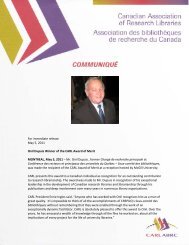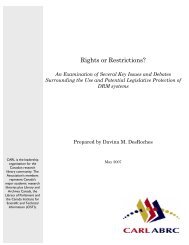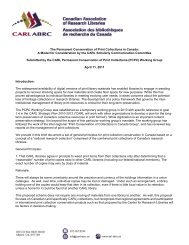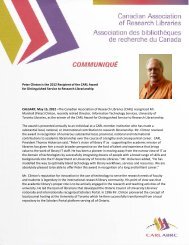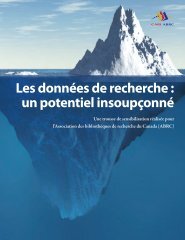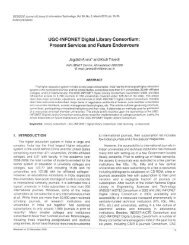PDF - CARL - ABRC
PDF - CARL - ABRC
PDF - CARL - ABRC
You also want an ePaper? Increase the reach of your titles
YUMPU automatically turns print PDFs into web optimized ePapers that Google loves.
Special Collections in ARL Libraries<br />
March 2009<br />
surrounding digitization of works in copyright and the issues of fair use and open access, as well as mass digitization<br />
simply extending its reach. Special collections from the 19th century and earlier, or indeed from any period up to the date<br />
of 1923 when copyright begins to kick in (in the US), have a special attraction because they present fewer problems of<br />
selection, rights clearance, and so on, than the large general collections that run over long periods.<br />
As there come to be diminishing returns from digitizing the books that most or many large libraries possess, the<br />
rare and unique become more attractive, even if more of a challenge to handle. Promoting access to special collections<br />
through large-scale digitization is a real opportunity for certain sorts of materials in particular: pamphlets, which can be<br />
handled in a similar way to books and in some cases using the same scanning equipment, even though calling for special<br />
care; rare books for the same reasons and with the same caveats; manuscripts and other unbound archival materials,<br />
maps, ephemera and other flat paper collections that lend themselves to treatment page by page.<br />
The “mass” approach also presents a whole range of special difficulties. Fragile material must be monitored by<br />
preservation experts, special workflows are needed to handle material that is not necessarily stored in book form on<br />
shelves, but inside boxes or cabinets. It is critically important to ensure that partners, especially commercial partners,<br />
understand the complexity of rights in special collections materials, and that repositories assert and protect those<br />
rights. Nevertheless large-scale digitization is an exciting option that will almost certainly become a fact of life for a<br />
significant number of special collections librarians and archivists in the near future. It calls for its own set of criteria to set<br />
intelligent priorities and to define the key issues that must be negotiated with digitizing partners such as: requirements<br />
for physical handling, expectations for use of the digitized files, standards for the files that ensure integrity and long term<br />
preservation, and respect for the public domain and copyright. 30<br />
Creating Metadata<br />
Having made choices about the priorities for processing collections, what are the technical opportunities for enhancing<br />
access? Digitization is of course preeminently a means of access to the content of original source materials. But, it is<br />
worth repeating the fundamental truth that without a means of identifying the material, and navigating its context,<br />
access to a physical original source or its digitized version will be a hit-and-miss business. It is not best practice to digitize<br />
material for public access without ensuring that an appropriate level of metadata is also provided. 31 Digitization without<br />
metadata is an abrogation of stewardship.<br />
Digitization, which is sometimes easier to finance through donations or special grants than basic description, should<br />
complement and enhance the catalog record. While it is not a good option to digitize or otherwise publish surrogates<br />
without generating descriptive metadata at some level, decisions do have to be made about what an appropriate level<br />
may be for a particular collection. There is a range of nuanced choices. For example, choices can be made between<br />
cataloging in more detail at the outset or providing a preliminary record. A higher-level, more general description than<br />
custom might prescribe can be revisited at a future date; and in the meantime, if it opens up a collection that has been<br />
effectively hidden, that enhances access. Broad collection-level description is worth doing for that reason alone.<br />
30 See, for example, Rick Johnson, “In Google’s Broad Wake: Taking Responsibility for Shaping the Global Digital Library,” ARL: A Bimonthly<br />
Report... http://www.arl.org/bm~doc/arlbr250digprinciples.pdf.<br />
31 One exception to this rule would be providing scanned images of material precisely so that it can be cataloged by someone working<br />
remotely.<br />
Page 22 www.arl.org/bm~doc/scwg-report.pdf



